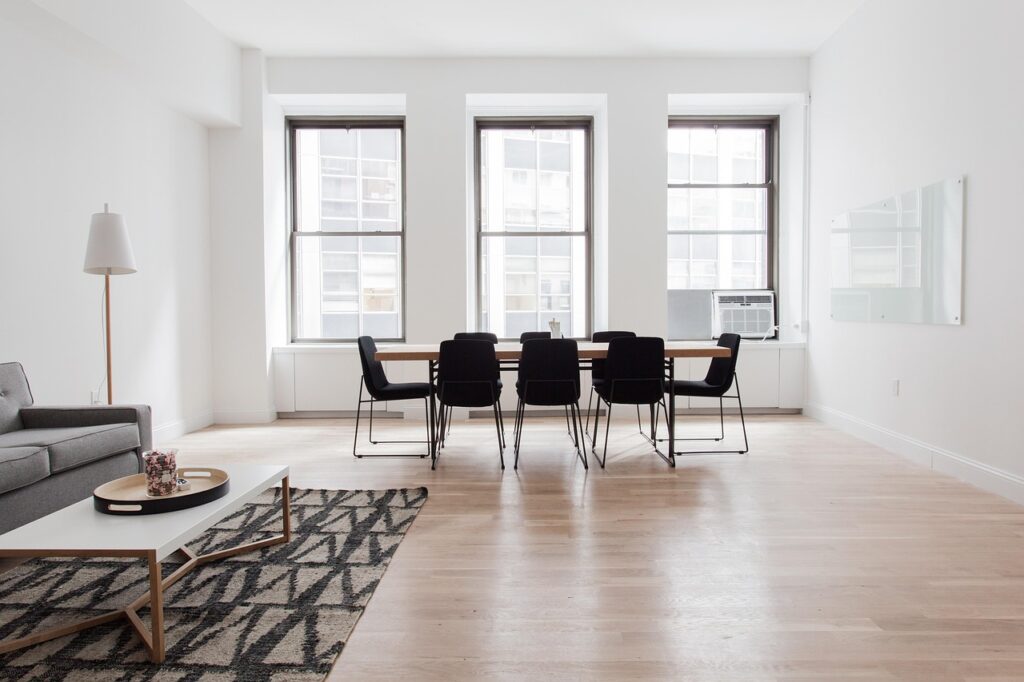Minimalism has been a prevailing trend in interior design, reshaping homes with its emphasis on simplicity and functionality. At the core of this aesthetic movement are the principles of clean lines, natural materials, and a palette that favours neutrality. One element that perfectly encapsulates these values, while adding warmth and texture to modern homes, is the Scandinavian rug.
Understanding Minimalism in Interior Design
The minimalist approach to interior design emphasises the idea of ‘less is more’. It advocates for clutter-free spaces that are both visually appealing and tranquil. By focusing on essential functional elements and eliminating superfluous decor, minimalism facilitates a serene living environment. This design philosophy further accentuates the importance of quality over quantity, highlighting craftsmanship and durability.
Incorporating a minimalist design often involves a subtle colour scheme, with shades of white, beige, and grey taking precedence. Such interiors benefit incredibly from the addition of understated adornments that serve a purpose, whether for comfort, utility, or both.
The Scandinavian Influence
The Scandinavian interior design style, originating from the Nordic countries, mirrors many of the values inherent to minimalism. It promotes cleanliness, light, and an unencumbered space while retaining a homely and inviting atmosphere. An integral component of this style is the utilisation of Scandinavian rugs, which effortlessly blend practicality with understated elegance.
Scandinavian design pays homage to the natural world, with a focus on organic materials and earthy motifs. By embodying these elements, Scandinavian rugs can yield a harmonious balance in any modern home, augmenting its minimalist ethos.
The Role of Scandinavian Rugs in Minimalism
Rugs in general have the power to transform a space, but Scandinavian rugs, in particular, are lauded for their versatility and distinctive aesthetic. These rugs are known for their simple patterns, muted colours, and durable construction, which align perfectly with the minimalist doctrine. They help define areas within open-plan spaces, and subtly add texture and depth without disrupting the visual flow.
Moreover, the softness and warmth they provide counterbalance the sleek surfaces commonly found in modern homes, such as hardwood floors or polished concrete. The tactile experience of a Scandinavian rug underfoot imparts a sense of solace, without clashing with the minimalist milieu.
Selection and Placement
When selecting a Scandinavian rug for a minimalist home, it’s important to consider size, colour, and pattern. A rug should be proportionate to the room and furniture it accompanies, taking care not to overwhelm the space. Colours typically favoured include ivory, light greys, and pastel hues, complementing a neutral colour palette with an air of sophistication. Patterns, if present, are subtle and often geometric or nature-inspired.
The placement of a Scandinavian rug can be equally strategic. Whether situated under a coffee table, anchoring a seating area, or laid out in a bedroom for a plush landing in the morning, its position should display intentionality and purpose.
Practical Benefits
Beyond aesthetics, Scandinavian rugs offer practical benefits. They lend insulation to rooms, create a noise-dampening effect, and can protect flooring from wear and tear. These utilitarian advantages are crucial for maintaining the pristine condition expected within a minimalist home.
Emphasising Sustainability
Often made from sustainable materials like wool or recycled cotton, Scandinavian rugs also align with the growing preference for eco-friendly home furnishings. The emphasis on sustainability and responsible production is a hallmark of both Scandinavian design and contemporary minimalism, reflecting a worldwide shift towards conscientious consumption.
Maintaining a Balanced Decor
To maintain a balanced and cohesive decor, accessories such as throw pillows, artwork, or lighting fixtures that accompany a Scandinavian rug should adhere to the minimalist philosophy. Simple silhouettes, natural textures, and functionality should be the guiding criteria for any additional home embellishments.
In conclusion, the blending of Scandinavian rugs into minimalistic homes is not merely a trend but a thoughtful design choice that highlights elegance, comfort, and sustainability. These rugs serve as a testament to the timeless appeal of minimalism and the continued relevance of Scandinavian design elements.
The marriage of functionality with aesthetic simplicity that Scandinavian rugs offer ensures that these versatile pieces remain a cornerstone in minimalist interior design. Their capacity to infuse warmth into modern homes while upholding the integrity of minimalist principles is unparalleled.
As homeowners continue to appreciate the tranquillity of minimalist spaces, the Scandinavian rug stands as an enduring emblem of tasteful refinement. For those contemplating a minimalist revamp or simply seeking an elegant touch, the introduction of a Scandinavian rug into the home is a worthy consideration that harmonises practicality with polished grace.
Embracing minimalism within the home need not equate to coldness or sterility. Instead, it invites a calm, uncluttered existence, enhanced by the carefully chosen textures and comforting embrace of Scandinavian rugs. Such an approach to home design not only reinforces the pursuit of serenity but also encourages a living space that resonates with purity and intention.



